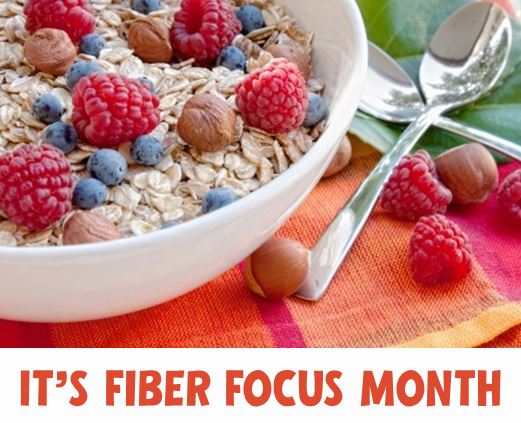 As hokey as health related holidays may seem, I love them. This is because they prompt us to delve into topics that have become trite. January is recognized as National Fiber Focus Month. I am sure you have all heard a lot about fiber and how it is good for your digestive tract...but, as January comes to a close, I encourage you to take a deeper look at how fiber can have a pretty awesome impact on your health.
As hokey as health related holidays may seem, I love them. This is because they prompt us to delve into topics that have become trite. January is recognized as National Fiber Focus Month. I am sure you have all heard a lot about fiber and how it is good for your digestive tract...but, as January comes to a close, I encourage you to take a deeper look at how fiber can have a pretty awesome impact on your health.
Fiber can have several different traits. It can be classified as:
- Viscous, which forms a gel in water, or non-viscous
AND/OR
- Fermentable, meaning it is fermented by bacteria in the colon, or non-fermentable
You can find fiber in plant-based foods including whole grains, fruits, vegetables, nuts, seeds, and pulses. These natural sources are referred to as dietary sources of fiber. Fiber is also found as an isolated form that is often added to foods, such as chicory root or inulin in a granola bar. These isolated sources are referred to as functional fiber. Although all sources of fiber are beneficial, fiber that is naturally present in foods ─ such as whole grains ─ are proven to have the greatest health benefit through their correlation with reduced risk of chronic disease.
The Significance of Being “Regular”
We all have heard about the connection between eating fiber and being more regular. This is because fiber can bulk up and soften your stool, making it pass through your system more quickly and easily. Soluble fiber’s ability to absorb water can also help to resolve diarrhea. The effect of fiber can stretch well beyond just your bowel movements, though. Through these actions, it can reduce the concentrations of cancer causing carcinogens and limit the amount of time the colon is exposed to these toxins, thus reducing the risk of colorectal cancer.
 Certain fibers that are fermented in the gut also produce short chain fatty acids as a byproduct. These not only promote greater mineral absorption from the food you eat but also promote healthy cells in the colon which further prevents cancer. By enabling the quick and easy passage of food through the digestive system, fiber prevents matter from getting trapped in small pockets of the GI tract, reducing the risk of diverticular disease and painful infections.
Certain fibers that are fermented in the gut also produce short chain fatty acids as a byproduct. These not only promote greater mineral absorption from the food you eat but also promote healthy cells in the colon which further prevents cancer. By enabling the quick and easy passage of food through the digestive system, fiber prevents matter from getting trapped in small pockets of the GI tract, reducing the risk of diverticular disease and painful infections.
Soluble fiber, with its absorptive abilities, absorbs sugar and bile acid, causing them to be excreted from the body. This helps to regulate your blood sugar and reduces the cholesterol levels in your blood. Fiber also delays the rate at which stomach contents are released into the intestines. This aids in normalizing blood sugar as well as controlling appetite and weight. Consuming more fiber may also improve blood pressure, HDL (good) cholesterol, triglycerides, and reduce the inflammation that is associated with heart disease. Together, these functions may be behind a reduction in diabetes and cardiovascular disease.
Fiber also greatly affects the helpful bacteria in your gut, a key area in digestion and the immune system. This is an exciting new area of research which could uncover how vastly fiber affects human health and wellbeing.
How Can You Be Sure You Are Getting Enough Fiber?
The recommended intake for fiber is about 14 grams per 1,000 calories. This typically translates into about 25 grams per day for women and 38 grams per day for men. It is estimated that only 5% of the United States population meets these recommendations, which means a whopping 95% of the population is missing out on these benefits! Incorporating fiber-rich whole foods can also allow you to enjoy the many health benefits of antioxidants.
 Even as National Fiber Focus Month comes to a close, it’s not too late to get in on fiber’s health benefits. In observation, I encourage you to make easy changes to your nutritional intake, such as:
Even as National Fiber Focus Month comes to a close, it’s not too late to get in on fiber’s health benefits. In observation, I encourage you to make easy changes to your nutritional intake, such as:
- Swapping out your white rice for brown rice or quinoa
- Trying whole grain pasta instead of white pasta
- Eating oatmeal at breakfast
- Choosing whole wheat bread for your sandwich
- Adding veggies to your main dishes
- Having a salad before every meal
- Eating nuts as a snack
- Adding sliced fruit to your morning routine
Simple (and yummy!) changes in your diet can have some pretty big effects!
Learn More About Fiber in Our Guide:

Read More:
- Why is Fiber Good for You? 4 Reasons to Eat More Whole Foods
- Great Harvest Offers Healthy High Fiber Products
- Healthy Eating Doesn’t Have to Be Hard
Works Cited:
Institute of Medicine, Food Nutrition Board. Dietary Reference Intakes for Energy, Carbohydrates, Fiber, Fat, Fatty Acids, Cholesterol, Protein, and Amino Acids. Washington, DC: The National Academies Press; 2005. Web.
Dahl, Wendy J., and Maria L. Stewart. "Position of the Academy of Nutrition and Dietetics: Health Implications of Dietary Fiber." Journal of the Academy of Nutrition and Dietetics 115.11 (2015): 1861-870. Web.
Image credits: © hubavasi / 123RF Stock Photo, © chajamp / 123RF Stock Photo, both modified by text overlay.




